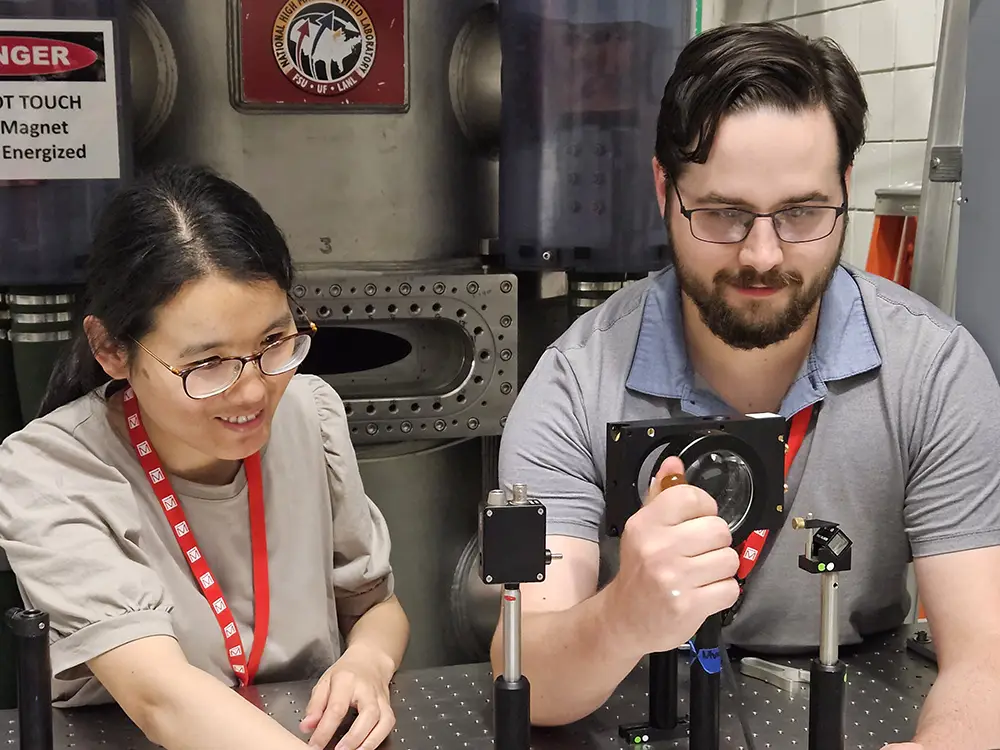UT Team Finds Unexpected Behavior in Magnetized Material

A semiconducting blend of manganese, silicon, and tellurium has excited a team of UT-led collaborators with its unexpected behavior when exposed to a magnetic field. The material’s response could lead to an improved effect of colossal magnetoresistance for use in data storage and sensors.
Chemistry Professor Jan Musfeldt, along with post-doctoral researchers Yanhong Gu and Kevin Smith, collaborated with an interdisciplinary group of colleagues from across the country to publish their findings in Nature Communications in September.
When exposed to a magnetic field, the semiconducting material Mn3Si2Te6 can change from an insulator—which doesn’t conduct electricity—to a “bad metal”—which will. Curiously, this change occurs in the absence of phenomena that are normally expected including double-exchange interactions and Jahn-Teller distortions. It also comes with colossal magnetoresistance (CMR), a massive increase in its ability to resist electrical current. There is also evidence that suggests the material exhibits a new kind of quantum state involving chiral orbital currents, magnet currents that move in looping patterns.
“Colossal magnetoresistance is the key property for making hard drives, i.e. magnetic memory,” said Musfeldt. “This work reveals that the traditional mechanisms for creating this effect can be circumvented, opening entirely new strategies for creating CMR materials.”
Musfeldt’s research group uses spectroscopy to explore the behavior of quantum materials like these under extreme conditions. In addition to high magnetic fields, they use high pressures, small size, and photochemical activation to tune properties.
“For future research, we will continue to study this compound and try to understand the origin of the localized excitations,” said Gu. “We will do measurements that focus on the orbitals of the manganese ions that relate to the chiral orbital currents.”
The interdisciplinary collaborators on the Nature paper, titled “Unconventional insulator-to-metal phase transition in Mn3Si2Te6,” include Distinguished Professor Elbio Dagotto, Assistant Professor Yang Zhang, and post-doctoral researcher Ling-Fang Lin, all of the UT Department of Physics and Astronomy and Oak Ridge National Laboratory.
Other contributors include colleagues at Brookhaven National Laboratory, Rutgers University, the University of Minnesota, Korea’s Pohang University of Science and Technology, and—notably—the National High Magnetic Field Laboratory at Florida State University.
“This is great work that combines high magnetic-field studies with infrared measurements,” said Gu. “I really enjoyed the entire process of the experiment, as well as the discussions with scientists at the High Magnetic Field facility and other universities. It provides a great opportunity to bond and collaborate with other research groups.”
The effect of colossal magnetoresistance in these materials should prove useful in sensor devices where precise positioning is needed.
“You couple a magnet and the CMR material and have the material sense the field,” said Smith. “Due to the nature of CMR, once the material senses the field, the resistance will change greatly. This can be used as a feedback loop to accurately monitor the position of devices in cars, for manufacturing, or in precision medical equipment. It’s very remarkable stuff.”
The team will continue to delve into the way this phenomenon works in materials, within their own lab and in collaboration with partners at UT and other institutions.
“It’s very important to learn more about the mechanism of these effects, whether chiral loop currents play a role or whether short-range antiferromagnetic interactions are the most important,” said Musfeldt. “This builds on many important discoveries, such as new quantum states or new types of superconductivity.”
By Randall Brown